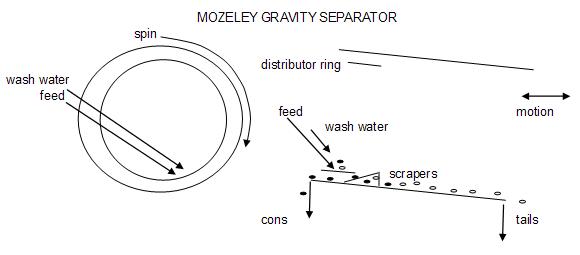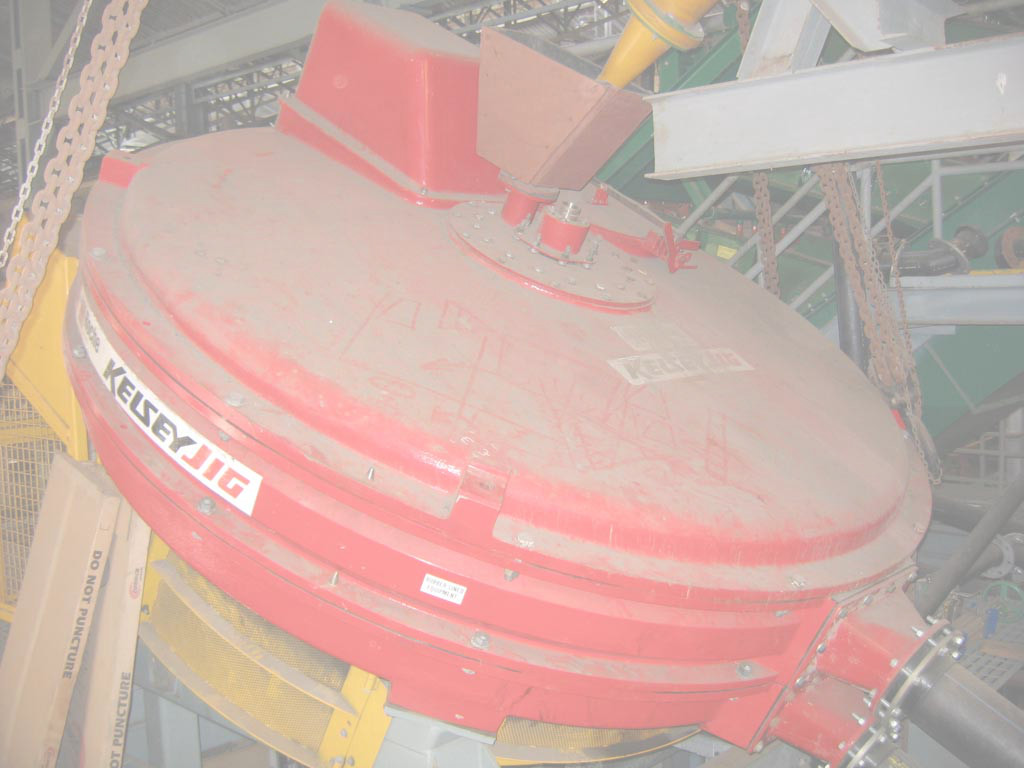

 |
|||
 |
 |
 |
 |
Gravity Separation
Gravity separation uses differences in specific gravity (SG) between various minerals to achieve a separation, and is normally a wet process although examples of dry gravity separators exist. Gravity separation works best when there is a large difference in the SG in the minerals to be separated, and the particle size is similar and not excessively fine, and shape is rounded. The choice of separator is generally determined by these factors and includes the following:
Conventional jigs
Examples of conventional jigs include those manufactured by IHC, the Russell jig manufactured by Amtas, and the In Line Pressure Jig (ILPJ) manufactured by Gekkos.
Jigs are commonly used as a primary stage to recover coarse liberated minerals sized 2mm and above. Feed slurry is distributed into the hutch which consists of a moving slurry bed located above a screen and is subjected to a pulsating motion and upward hutch water flow which alternately causes dilation and compaction. The pulsation can be caused by a diaphragm (in the case of the Russell jig) or by mechanical movement of the screen (as in the ILPJ). Separation is also assisted by a ragging material of intermediate SG, with the result being that high SG (concentrate) particles pass through the ragging and screen and are removed via the hutch, while low SG particles (tailings) discharge over the lip of the hutch.
Operating variables include:

Spirals
Examples of spirals are manufactured by Mineral Technologies,and Multotec and are popular due to their low maintenance and simplicity, and higher separation efficiency than pinched sluice devices.
Spirals are commonly used to separate sand sized particles with moderate SG differential in the range -2mm +75um, although varieties exist that can separate reasonably efficiently down to 63um. Below this size range efficiency falls off rapidly, and enhanced fine gravity separators are generally required.
Spirals are made of fiberglass onto which smooth urethane surface is molded to form a trough in the shape of a spiral as the name suggests. Between individual spiral types, the profile of the trough and the pitch as well as the diameter and height and number of turns can vary according to duty. Feed slurry is introduced at the top and is subjected to a combination of gravitational and centrifugal forces imparted by its motion down the spiral. This causes high SG minerals to move towards the centre of the trough and water and low SG minerals towards the outside. The segregated slurry discharging from the spiral at the bottom can thus be separated by cutters into high SG (concentrate) and low SG (tailings) together with intermediate SG (middling).
The choice of spiral depends on the duty: rougher / scavenger or cleaner; the feed grade: low / medium / high; and the particle size: sand / fine. Typically rougher / scavenger spirals where the feed type favorable for easy separation and overall throughput is large are high capacity designs with triple or quadruple to reduce floor area. Cleaner and fine spirals where overall throughput is less and separation more difficult are typically operated at lower feed rates, and as twin starts to assist access for operational requirements. Cleaning spirals are also available with wash water.
Operating variables include:
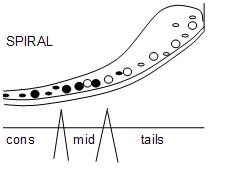
Pinched sluices
An example of a pinched sluice is the Reichert cone, manufactured by Mineral Technologies, which is a derivative of the older tray pinched sluice separator.
Pinched sluices were commonly used to separate sand sized particles with moderate SG difference prior to the appearance of the modern day spiral in the 1980s. They operate on the principle of stratification of particles of differing SG on an inclined surface, area of which becomes smaller “pinched” as the slurry flows down the slope, with high SG grains on the bottom and low SG grains on the top. High SG (concentrate) grains are removed through a slot, while low SG (tailing) discharges off the end. Reichert cones normally have multi stage cons cleaning and water addition to maintain optimum density.
The operating variables include:
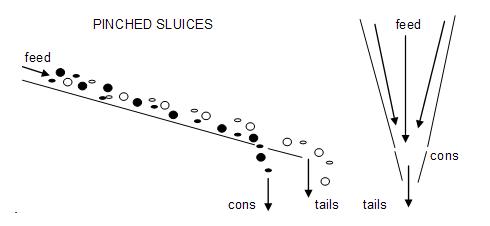
Centrifugal jigs
An example of a centrifugal jig is the Kelsey jig, manufactured by Mineral Technologies. This incorporates the pulsing action, water injection and the use of a ragging medium and internal screen of a conventional jig, but in addition centrifugal spinning motion to enhance the gravity separation. This enables sand sized minerals of fairly similar SG as well as fine minerals to be separated more efficiently. Because of the additional processes used the Kelsey jig is significantly more expensive and complex to operate and maintain. The feed to a Kelsey jig must be screened at a size less than the internal screen to avoid pegging, and the tailings must be screened in order to recover ragging as oversize. In order to maintain operational and mechanical efficiency the Kelsey jig must have the internal screen cleaned daily and some of the moving parts checked and greased. This can now be done automatically, but the feed must still be stopped. The Kelsey jig is offered in two models: the J1300 and J1800, the latter having greater capacity.
Operating variables include:
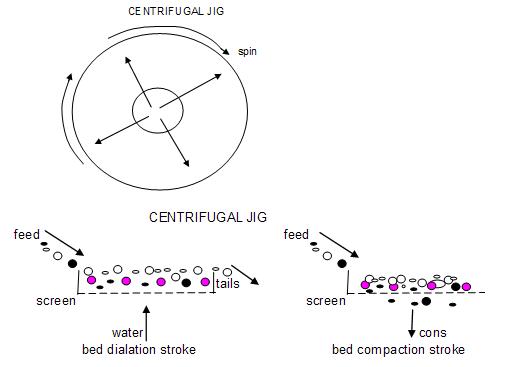
Centrifugal concentrators
Examples of centrifugal concentrators include the Falcon C and Ultra Fine (U/F) types manufactured by Sepro and the Knelson CVD manufactured by Knelson.
The Falcon C and Knelson CVD are derivatives of the SB types (semi batch) used extensively in the gold industry, but provide continuous discharge of concentrate to enable higher grade feeds to be processed without having to shut down. The recently developed Falcon U/F is a batch machine and spins at extremely high (up to 600G) rates in order to target very fine particles. They all utilize the centrifugal force generated by spin to enhance gravity and enable SG separation on finer particles to be achieved. Feed slurry enters centrally and is distributed outwards at the base of the cone by centrifugal force and then flows up the inclined surface of the bowl, segregating in the process, with high SG particles on the outside closest to the bowl surface and low SG particles on the inside which discharge over the lip at the top of the bowl.
The Falcon C spins at high rates and can generate a G force of up to 200, and features a positioning valve for continuous concentrate discharge, while the Knelson CVD operates at lower G force (up to 150G), but has an injection water system which fluidizes the bed and assists separation. All three separators have different bowl profiles.
Operating variables include:
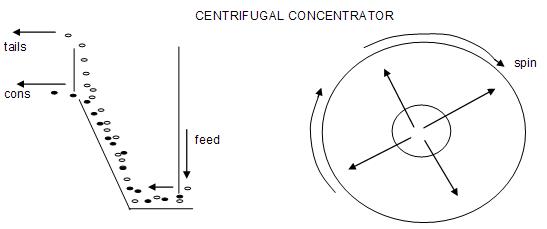
Shaking tables (wet and dry)
Examples of wet shaking tables include the Wilfley made by Mineral Technologies, and the Deister made by Deisterconcentrators.
Shaking tables have been used for many years in gravity separation, and although limited in capacity, they produce a high upgrade, can handle a wide range of SGs, are very visual and operator dependent and are still used for cleaning stages to produce final concentrates.
Feed slurry is distributed at the head of the table via a launder, together with wash water, and spreads out across the inclined surface on the basis of particle SG, with high SG grains moving along the top of the flowing film to discharge off the far end as concentrate, while low SG grains move down the inclined slope of the table with the majority of the water to discharge at the bottom as tailings. The particle separation is assisted by the backwards and forwards motion (stroke) of the table, the tilt (both longitudinally and laterally), wash water applied along the length of the table, and riffles.
Operating variables include:
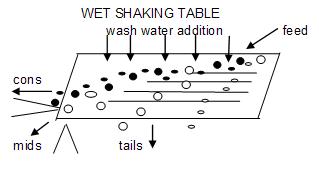
Dry shaking tables or air tables have specialized dry gravity separation applications such as fine quartz and zircon and consist of a table covered in cloth through which low pressure air is forced through by fans located underneath and controlled by dampers so that particles are partially fluidized and segregate according to SG and size, under the influence of stroke and tilt and discharge separately with the aid of splitters. The forces acting on the particles on air tables reverse the pattern of wet tables with the low SG grains discharging at the top of the table.
Operating variables include:
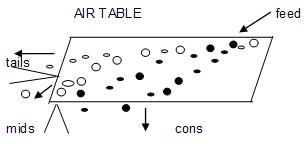
Mozeley gravity separators (MGS)
The Mozeley gravity separator, manufactured by Gravity Mining combines the centrifugal motion of a spinning drum to enhance fine gravity separation with the shaking motion of a table, making it suitable for upgrading of low tonnage rate fine particle slurries.
Feed slurry enters the MGS and is distributed onto a perforated feed ring mounted internally near the top end of an inclined spinning drum, together with wash water. The diluted slurry is thus subjected to centrifugal and shaking forces which cause the high SG particles to move up the inclined drum and low SG particles to move down the drum slope to discharge as tailings. Discharge of the high SG (concentrate) particles is assisted by internal scrapers which rotate at a speed slightly faster than the drum.
Operating variables include:
